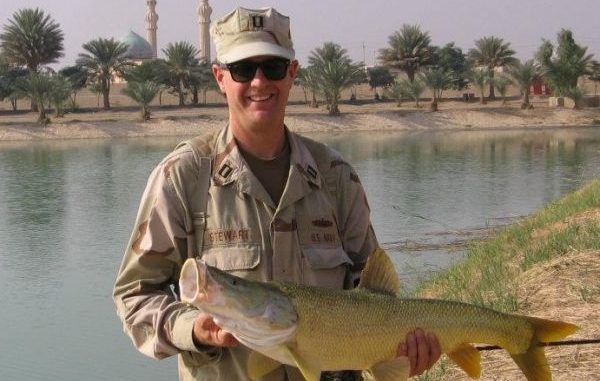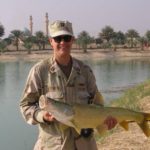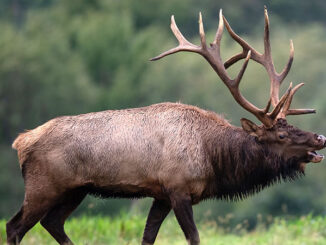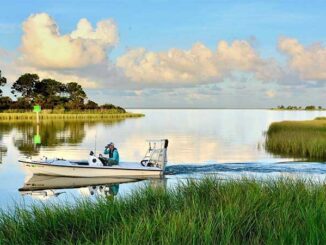
Sailor’s story a great Christmas gift
Looking for something different to put under the tree for that angler who has everything? Think outside the tackle box.
The movie “Salmon Fishing in the Yemen” is now out on DVD. One of the most-popular films of this year, it’s the fictitious story of three very diverse people who put their differences aside to help bring fly fishing to the Middle East.
Then there’s the true story of one of America’s heroes who helped bring fly fishing to Iraq — and to many hundreds of soldiers away from home.
Commander Joel Stewart, U.S. Navy, chronicles his life story, with an emphasis on his tour of duty in that country, in his book, “A Fly Rod In My Sea Bag: Fishing Adventures in Baghdad During Operation Iraqi Freedom 2005-2011.”
Stewart grew up in Montana, and took to fly fishing at age 6 and to tying flies at 8 years old. By the time he was 12, he was a commercial tyer, providing a couple of the local outdoor stores with inventory.
After he graduated from high school, Stewart decided to join the military, at least long enough to earn money for college. He enlisted in the Navy due to better opportunities for training and travel. As a sailor, he developed a passion for military life, made many new friends, met his wife and discovered many new fishing experiences.
Stewart’s dream was to command a Navy ship, but that required being a commissioned officer, which required having a college degree. He attended University of New Mexico, in part, because there was excellent trout fishing near the school.
Fast-forward to January 2005: Lt. Stewart was selected to go to Iraq and serve in the Central Command of operations. His station would be at Camp Victory, formerly the compound that housed the palaces,and lakes,” of Saddam Hussein, his family and his administrators.
The dictator had stocked the lakes with various species of fish that could tolerate the hot climate. Despite rumors of “Saddam’s Bass,” there were no Micropterus salmoides. But there were asp, an aggressive species resembling bass, as well as ferocious fly-eaters like shaboot and giant mangar. More-familiar species were grass carp, bighead carp, and catfish.
Like any combat zone, things could be unnerving. Long periods of quiet, sometimes boredom were punctuated by violence. Seeking remedy from the anxiety was easy for Stewart, who had packed fly tackle in his bag. Fairly soon, he was becoming an expert on the fisheries of the 14 lakes and ponds inside the compound.
Fly fishing has often been described as “the quiet sport.” For Stewart, Saddam’s lakes didn’t quite offer the solace that the streams in his native Montana did. On several occasions, his fishing was interrupted by gunfire or mortar fire. On one occasion, a rocket landed in a lake about 400 meters from where he was fly-casting.
Pretty soon, his fellow service men and women began to take an interest in this thing called fly fishing, as an alternative to the other downtime activities like video games. At which point, Stewart started “The Baghdad School of Fly Fishing,” which later became “The Baghad Angler’s Club and School of Fly Fishing” as it grew to encompass standard fishing, as well.
With help from Americans at home, including companies like Rio, Temple Fork Outfitters, groups like the Federation of Fly Fishers and other entities — including the New Orleans Saints cheerleaders, the endeavor expanded beyond just a school and fishing club into an annual tournament with over 300 participants.
The Baghad Anglers Club is no more, as America withdraws from Iraq. The good news is that Iraqis are now fishing these once-forbidden lakes with knowledge gained from club members.
There’s a lot more to this book than many great fish stories. Stewart tells of the day-to-day operations in a battle zone, the sacrifices service men and women make for our country, and stories of these patriots whom Stewart befriended.
But just in case you’re more inclined to the fishing aspect, the appendix contains photos and recipes for the various flies the author used in Iraq,” most of which can be used for native fish here in Louisiana.
Speaking of Louisiana, Commander Joel Stewart spent this past year stationed in New Orleans as the executive officer for the U.S.S. Anchorage, newly constructed at Avondale Shipyards, readying the ship and its crew for duty. Sometime next spring, Stewart will assume command of the ship.
His dream come true!
For me and others in the Louisiana fly fishing community, it was an honor and privilege to become his friend and fishing buddy. During his time here, Stewart visited several clubs in the state, giving presentations and/or demonstrating his fly-tying skills.
And of course, he spent most of his free time fishing. Mostly around New Orleans City Park lakes, where he became infatuated with the Rio perch, which he describes as a great light-tackle species. He also fell in love with marsh fishing for bull reds, and vows to return frequently after retirement to catch the “Redzillas.”
Shortly before the Anchorage departed for its new home in San Diego, Joel invited a few in his fly-fishing circle,” including me and Mrs. Catch — for a personal tour of his ship. A naval ship is a community in itself, and what impressed us most were the multiple talents, the precision to details and the professionalism of 350 people, most of whom were in their early 20s. Our country is in good hands with these patriots.
“A Fly Rod In My Sea Bag” sells for $24.95, and is available from Whitefish Press, Amazon, and (locally) Uptown Angler in New Orleans and Green Trout Fly Shop in Denham Springs.
All royalties from the book go to Project Healing Waters, an organization that uses fly fishing to aid in the physical and emotional rehabilitation of disabled veterans.
I can’t think of a better Christmas gift. Can you?



